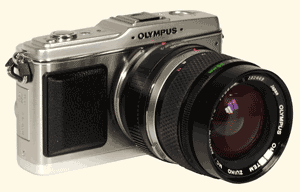|
OM ZUIKO LENSES ON OTHER OLYMPUS D-SLR's
Before reading this article I'd like to draw you attention to other articles on this website that test many OM Zuiko lenses on various E-System bodies:
OM ZUIKO LENSES TESTED ON E-1 8mm to 500mm.
OM ZUIKO LENSES ON E-330 16mm to 400mm.
OM ZUIKO LENSES TESTED WITH DANDELION AF ADAPTER ON E-3.
INTRODUCTION
There's little doubt about it - my old report about using OM Zuiko lenses on the E-1 has been one of the most popular articles on this website for many years. This alone demonstrates the interest in maintaining older legacy glass for use on the modern digital SLR cameras.
Since that first report I've repeated the tests with the E-330 which showed a small improvement. But the biggest improvement comes with the latest generation of E-System cameras such as the E-3, E-30 and E-620. On these cameras the OMZ's function much better and this must be related to improvements in the metering system and I suspect a re-design of the mirror and/or mirror and exposure box.
IS MICRO FOURTHIRDS BETTER?
With the introduction of the Micro FourThirds (MFT) concept having no mirror/mirror box and a shorter registration distance can we expect further improvements? I think so and the physics certainly suggests this to be likely. Certainly the Panasonic G1 has spawned a panoply of adapters for many legacy lenses and I believe Olympus thinks so too as the company has produced the MF-2 adapter specifically for the E-P1 suggesting that the older OM Zuiko lenses perform somewhat better on the new Micro FourThirds body than standard 4/3rds. I also note the Olympus MF-2 adapter is not accompanied by the warning sheet about OM lenses that came with the MF-1.
The other great advantage of newer Olympus bodies and MFT is the sensor based Image Stabilization (IS) offering at least 2 to 2.5 stops of light or ISO benefit.
Furthermore the ability of Olympus Live View cameras to enlarge the subject by 7 or 10X on the LCD screen at the press of a button greatly assists manual focus.
With all this in mind and having just recieved the MF-2 adapter (kindly from Mark Thackara at Olympus UK), today I set up the tripod in the garden and hefted out my OMZ prime lenses to mount on the E-P1 digital Pen. In all I've used 27 different OMZ's taking 3 exposures with each lens and spending several enjoyable hours doing so.
FOCUSING ON THE LCD
It would be remiss of me not to mention my experience with this feature of the E-P1. I use compact cameras with no viewfinder and when using AF there is little problem if the screen is a little washed out. The E-P1 has no viewfinder but offers a 3" screen that is very clear and can be read from shallow angles. BUT when it comes to manual focusing I have to say that if/when the sun is coming from behind you or striking the LCD from above, then accurate MF is virtually impossible. It's not that you can't see the screen, it's that the contrast is washed out making critical focus difficult/impossible. I tried several places in the garden before settling on erecting the tripod under the gazebo to take benefit from the shade. To make things worse, with wide angle lenses where the subject is 'pushed' away from you, the problem is exacerbated by the screen resolution. I thought I was being clever when I used a magnifier to aid with focusing and while it helped a little it only magnified the screens pixel lattice which was of limited use. I don't profess to have a solution but there is a problem with MF in brighter conditions.
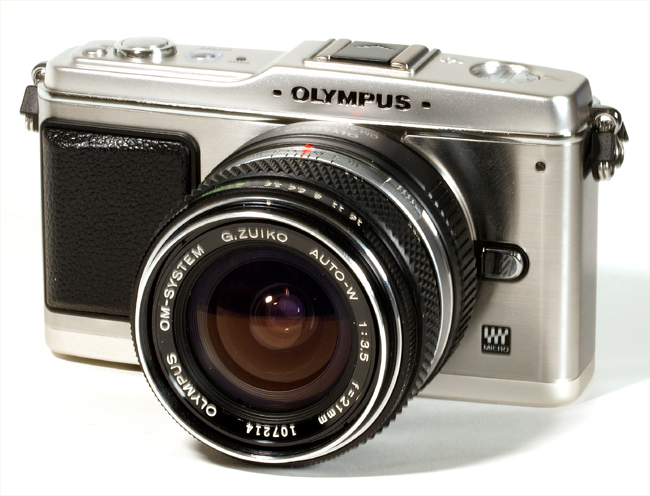
E-P1 with MF-2 adapter and OM Zuiko 21mm/3.5 - a small and ideal 'standard' lens equivalent to 42mm.
|
LENSES USED & CAMERA SETTINGS
Starting with the 8mm Fisheye and ending with the 600mm Super Telephoto I took one shot wide open, the next at f=5.6 (where appropriate) and the final one at f=11. This has produced over 80 images. It's simply not possible to show them all here so I've restricted the featured images to those at f=5.6 and will comment about performance at other apertures as necessary.
Yesterday was too sunny and I was running out of shutter speed with the fast primes; today however is quite cloudy with occasional sunny periods and I've endeavoured to shoot only when the sun is clouded over.
My current experience using OM Zuiko's on the latest 4/3rds camera suggests the old rule of thumb of applying -0.3 to -0.7 compensation automatically is no longer necessary in 'normal' conditions (like today). Furthermore I did not wish to skew the results by applying ad hoc compensation - I simply let the camera do its job. The images are centred on a small target that becomes obvious at around 35mm. The tripod was not moved during the testing session. E-P1 is set to ISO 100; ESP metering; MF; IS Off; Anti-shock 4 seconds; Large SuperFine JPG + RAW; Gradation Normal, NF Off; NR Off; Picture Mode Natural; Level Gauge On; Picture Mode = Natural; all else default.
GHOSTING
You will come across the word 'ghosting' in the following article many times. This phenomena is caused by light bouncing around the exposure box creating a peculiar softness in the image almost akin to a double image. It is more prevalent when the light source is strong. This occurs with all E-System cameras I've used when using most fast OM Zuiko lenses wide open and is to do with light being reflected back and forth between the camera sensor and the rear element of the lens. The larger the rear element, its curvature and distance from the sensor, the greater can be the problem. Here is an example taken with the OMZ 50mm x 1.2 (rear element 38mm diam) fast standard lens wide open next to the same scene in the same conditions taken within seconds at f=8, on the E-P1.
The above explanation of this phenomena is based on my observation of its occurrence with several 4/3rds machines. It is however only my opinion. Until there's a fully rationalized explanation of this phenomena I offer this as a possible cause.

The left image has a ghostly, shimmering ethereal look about it whereas the right one is an accurate and sharp rendition of the actual scene. I call this 'ghosting' though I'm not sure if this is the right terminology.
|
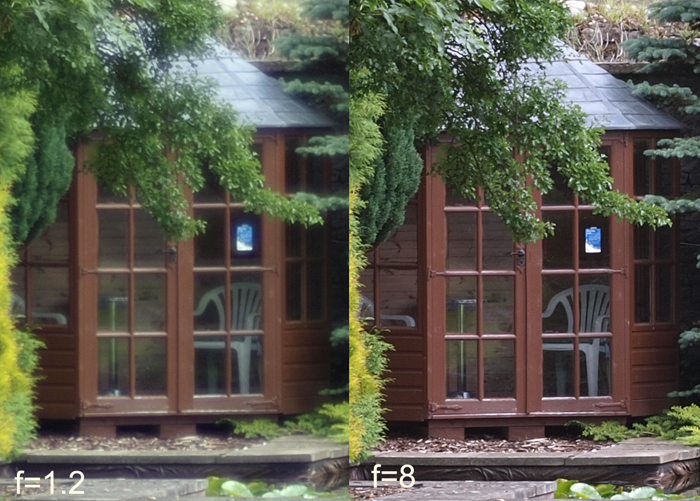
Here's a further crop showing the effect in more detail. It's as though the lens was fitted with a greased filter in much the same way as portrait photographers used that technique to produce softened images with an ethereal look. If you examine the blue & white notice in the window you can see a hazy coloured halo around it in the open aperture rendition.
|
TEST SESSION RESULTS
This is a lengthy document so I've split it into the 5 sections with links for ease of navigation.
NOTES
The distance from E-P1 CCD to the target is 120 feet which for most of the lenses used would infer an infinity setting on the focus ring. However the MF-2 adapter allows focus past infinity thus rendering the depth of field lens scale useless and subsequent use of hyperfocal distance to control/predict depth of field.
The images shown below have not been manipulated in any way other than labeling and re-sizing for the web. The full size jpg's are straight from the camera and I have the original RAW's if anyone wants these for further study or developing.
Click the image for the full size jpg and download if you wish. I am always happy to receive feedback or to share in your personal experiences with whatever legacy lenses you are using.
FISHEYE & WIDE ANGLE 8MM TO 35MM
Lenses: 8/2.8; 16/3.5; 18/3.5; 21/3.5; 24/2.8; 24/2; 28/2.8; 28/2; 35/2.8; 35/2.
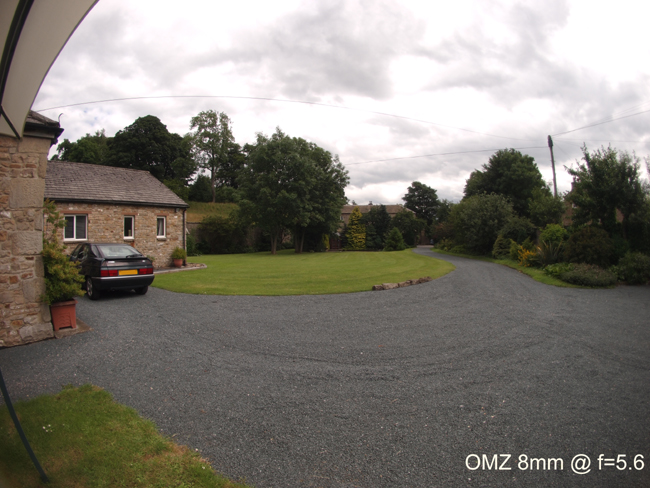
8mm Fisheye: Very difficult to focus even with MF assist 10X; I used a magnifier on the LCD. There is evidence of light fall-off in the darker corners but less than you'd imagine. Also areas of purple fringing in high contrast regions. Generally soft. The result at f=2.8 is much softer and ghosted; the version at f=11 is slightly softer but no ghosting. As you can see the image is not circular as it is in 35mm format. It is possible to use this lens with practice but it's not particularly practical in use due to the huge front element. Note the wonderful distortion; this lens can produce some fun images.
Click image for full size version.
|
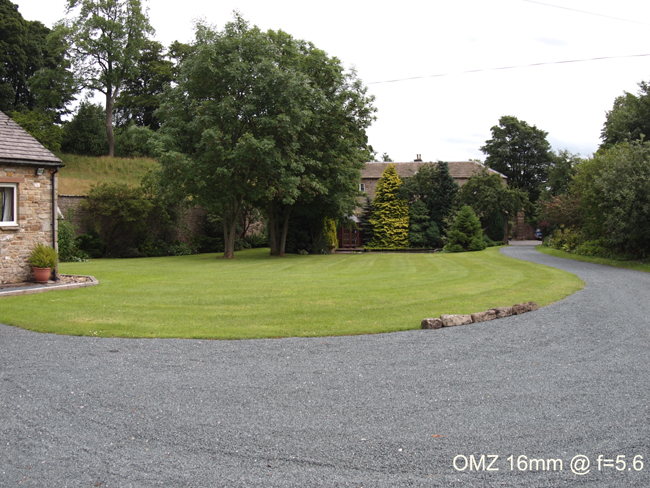
16mm Fisheye: Also very difficult to focus even with MF assist 10X; I used a magnifier on the LCD. Little evidence of purple fringing. Sharpness is soft to reasonable. The result at f=3.5 is much softer but not ghosted, if you HAD to use it wide open you could; the version at f=11 is definitely softer but no ghosting - I'd judge refraction was just setting in. As with all OMZ W/A lenses because of the 2X crop factor the equivalent focal length is disappointing - a 32mm f=3.5 is nothing special; quite useable f3.5 to f11, best between f4-8.
Click image for full size version.
|
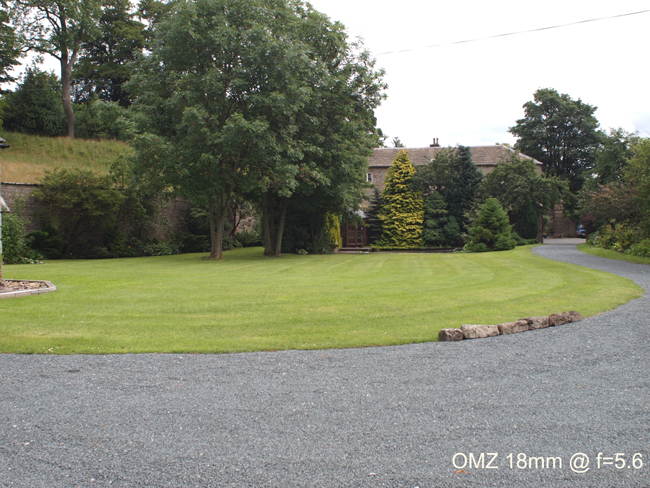
18mm: Also very difficult to focus even with MF assist 10X; I used a magnifier on the LCD. No evidence of purple fringing. Sharpness is soft - this may be due to human error as these W/A lenses are extremely difficult to focus though I'm pretty sure I nailed it. The result at f=3.5 is a tad softer but not much also not ghosted, perfectly usable wide open; the version at f=11 is slightly softer but no ghosting - not as bad as the 16mm and MAY be diffraction setting in. As with all OMZ W/A lenses because of the 2X crop factor the equivalent focal length is disappointing - a 36mm f=3.5 is nothing special; quite useable throughout aperture range to f=11 but sharpens up a tad stopped down.
Click image for full size version.
|

21mm x 3.5: Again difficult to focus even with MF assist 10X; I used a magnifier on the LCD. No evidence of purple fringing. Sharpness is soft to reasonable. The result at f=3.5 is just as good as at 5.6 with no ghosting being perfectly usable wide open; the version at f=11 is only slightly softer and MAY be diffraction setting in. As with all OMZ W/A lenses because of the 2X crop factor the equivalent focal length is disappointing - a 42mm f=3.5 is nothing special making a slow 'standard' lens; quite useable throughout aperture range to f=11 when it starts to soften.
Click image for full size version.
|

24mm x 2.8: Getting easier to focus with MF assist 10X; still, I used a magnifier on the LCD. No evidence of purple fringing. Sharpness is reasonable. The result at f=2.8 is just as good as at 5.6 with no ghosting being perfectly usable wide open; the version at f=11 is only slightly softer and MAY be diffraction setting in. As with all OMZ W/A lenses because of the 2X crop factor the equivalent focal length is disappointing - a 48mm f=2.8 is nothing special making only a reasonable 'standard' lens; that said it is quite useable throughout aperture range to f=11 when it starts to soften. I know many who use the 24mm x 2.8 as a 'standard' lens on 4/3rds cameras.
Click image for full size version.
|

24mm x 2.0: Getting easier to focus with MF assist 10X; still, I used a magnifier on the LCD. No evidence of purple fringing. Sharpness is heading towards being quite sharp. The result at f=2.0 is softer and displays some ghosting that spoils the result; the version at f=11 appears to my eyes just as sharp as the 5.6 version with no evidence of diffraction. As with all OMZ W/A lenses because of the 2X crop factor the equivalent focal length is disappointing - a 48mm f=2.0 is only special because it is fast but you cannot use that speed advantage because of ghosting. It is quite useable throughout aperture range f2.8 to (probably) f16 but not wide open.
Click image for full size version.
|

28mm x 2.8: Getting easier to focus with MF assist 10X; I dispensed with the magnifier on the LCD. A little evidence of purple fringing in high contrast areas. Sharpness is similar to the 24mm and is heading towards being quite sharp. The result at f=2.8 is almost as good being quite sharp with no ghosting; the version at f=11 appears to my eyes just as sharp as the 5.6 version with no evidence of diffraction. As with all OMZ W/A lenses because of the 2X crop factor the equivalent focal length is disappointing - a 56mm f=2.8 is only useful as a 'standard' lens. It is quite useable throughout aperture range f2.8 to (probably) f16.
Click image for full size version.
|
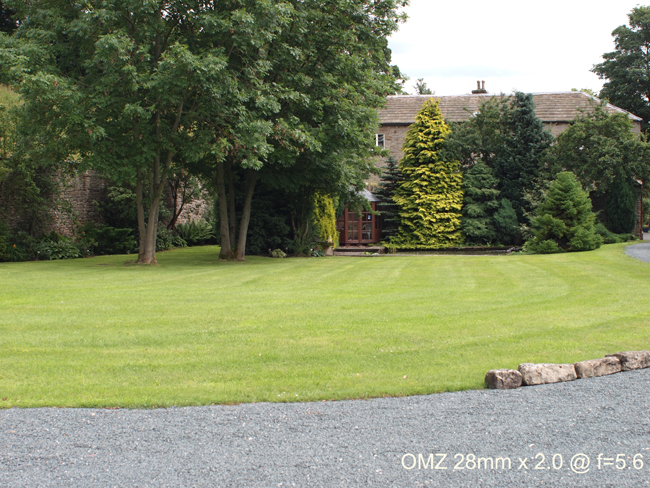
28mm x 2.0: Getting easier to focus with MF assist 10X; I dispensed with the magnifier on the LCD. Some evidence of purple fringing in high contrast areas. Sharpness is similar to the 28mm x 2.8 though may be a smigin softer. The result at f=2.0 is softer and displays some ghosting that spoils the result; the version at f=11 appears to my eyes just as sharp or even a tad sharper as the 5.6 version with no evidence of diffraction. As with all OMZ W/A lenses because of the 2X crop factor the equivalent focal length is disappointing - a 56mm f=2.0 is only useful as a fast 'standard' lens but cannot really be used wide open. It is quite useable throughout aperture range f2.8 to (probably) f16 but not wide open.
Click image for full size version.
|

35mm x 2.8: Focus quite easy with MF assist 10X. No evidence of purple fringing in high contrast areas. Sharpness is slightly down on the 28mm tending towards soft. The result at f=2.8 is much softer and, surprisingly for a 2.8 lens displays slight ghosting that spoils the result; the version at f=11 is sharper than the 5.6 result and there appears to be no diffraction. As with all OMZ W/A lenses because of the 2X crop factor the equivalent focal length is disappointing - a 70mm f=2.8 may have a limited use as an impromptu portrait lens. It is not usable wide open but OK when stopped down; tends to be soft. The version used is single coated silvernose.
Click image for full size version.
|

35mm x 2.0: Again, focus quite easy with MF assist 10X. No evidence of purple fringing in high contrast areas. Sharpness is similar to the 2.8 version - tends to be soft. The result at f=2.0 is much softer and displays slight ghosting that spoils the result; the version at f=11 is slightly sharper than the 5.6 result and there appears to be no diffraction. As with all OMZ W/A lenses because of the 2X crop factor the equivalent focal length is disappointing - a 70mm f=2.8 may have a limited use as a fast impromptu portrait lens. It is not usable wide open but OK when stopped down; tends to be soft. The version used is multi coated.
Click image for full size version.
|
STANDARD LENSES 50MM
Lenses: 40/2; 50/1.8; 50/1.4; 50/1.2.

40mm x 2.0: Focus easy with MF assist 10X. Slight evidence of purple fringing in high contrast areas in the f=2.0 result. Sharpness between soft and reasonable to my eyes. The result at f=2.0 is much softer and displays slight ghosting that spoils the result; the version at f=11 is slightly sharper than the 5.6 result - I can just read the 'FREE' on the container at 100%. Because of the 2X crop factor the equivalent focal length is 80mm and again, this lens may have a limited use as a fast impromptu portrait lens. It is not really usable wide open but OK when stopped down.
Click image for full size version.
|

50mm x 1.8: Focus easy with MF assist 10X. No areas to check for purple fringing. Sharpness is improving to quite sharp at f=5.6; satisfactory. The result at f=1.8 is a little softer but is spoiled by ghosting; the version at f=11 is starting to show diffraction - it is not quite as sharp and has the look of being slightly overexposed. Because of the 2X crop factor the EFL is 100mm making this lens usable as a fast portrait lens or slight telephoto. It is usable wide open with care but can ghost; OK when stopped down and is quite sharp to about f=10.
Click image for full size version.
|

50mm x 1.4: Focus easy with MF assist 10X. No areas to check for purple fringing. Sharpness is much the same as the f=1.8 version - quite sharp at f=5.6. The result at f=1.4 is softer and is spoiled by ghosting; the version at f=11 is just starting to show diffraction - it is not quite as sharp. Because of the 2X crop factor the EFL is 100mm making this lens usable as a fast portrait lens or slight telephoto. It is not really usable wide open but OK when stopped down and is quite sharp to about f=10.
Click image for full size version.
|

50mm x 1.2: Focus easy with MF assist 10X. No areas to check for purple fringing. Sharpness is slightly down on the previous examples but not that much; it is still reasonably sharp at f=5.6. The result at f=1.2 is much softer and is spoiled by a lot of ghosting; the version at f=11 is equal to the 5.6 result with no evidence of diffraction. Because of the 2X crop factor the EFL is 100mm suggesting this lens might make a fast portrait lens; but the results wide open are ghosted and only improve at f=2.0 so there is little adavantage over the slower versions. It is therefore not really usable wide open but OK when stopped down and is quite sharp to about f=11.
Click image for full size version.
|
TELEPHOTO LENSES 85MM TO 300MM
Lenses: 85/2; 90/2 Macro; 100/2.8; 100/2 ED; 135/3.5; 135/2.8; 180/2.8; 200/5; 200/4; 300/4.5.
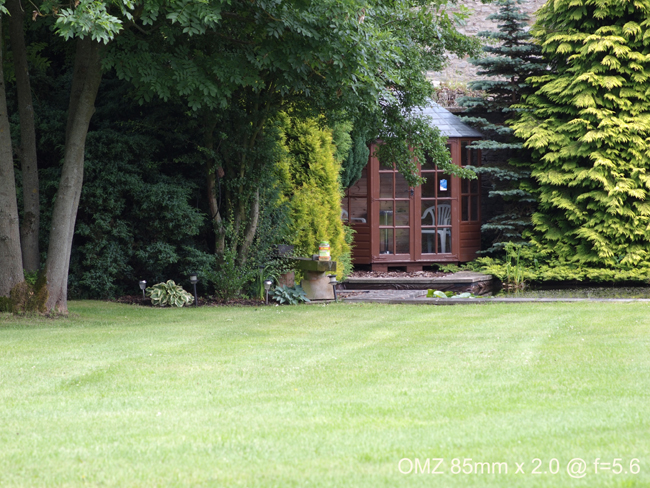
85mm x 2.0: Focus easy with MF assist 10X. No areas to check for purple fringing. As soon as we get to telephoto length the OMz's start to shine. I've had terrible results with this lens on the E-1/E-500 but it is improved on the E-P1. Sharpness is pretty good but not as good as I'd expect - probably because this lens was designed as a portrait lens with slightly soft focus; it is reasonably to quite sharp at f=5.6. The result at f=2.0 is way softer and is spoiled by a lot of ghosting; the version at f=11 is equal to the 5.6 result with no evidence of diffraction. Because of the 2X crop factor the EFL is 170mm making this lens a good fast medium telephoto; but the results wide open are ghosted and only improve with stopping down which negates the speed advantage. It is not really usable wide open but OK when stopped down and is quite sharp to about f=11.
Click image for full size version.
|
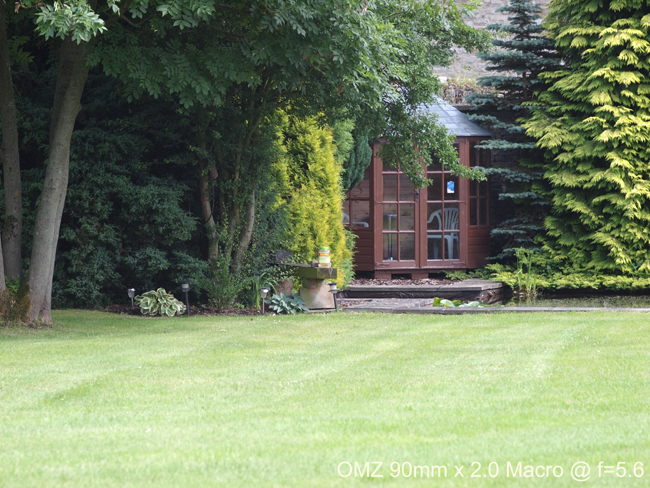
90mm x 2.0: Focus easy with MF assist 10X. A slight amount of purple fringing on the f=2.0 version not repeated. I've always had excellent results from the 90mm Macro with all my E-System cameras and use it in my 'studio' for magazine illustration. In this test target area sharpness is good but (obviously) this lens really shines when used close-up; here it's sharp at f=5.6. The result at f=2.0 is almost as sharp with virtually no ghosting and a tad of CA around the light; the version at f=11 is equal to the 5.6 result with no evidence of diffraction. The EFL is 180mm making this lens a good fast medium telephoto. It is eminently usable wide open with little discernable difference as the aperture is stopped down; sharp to f=11~16.
Click image for full size version.
|
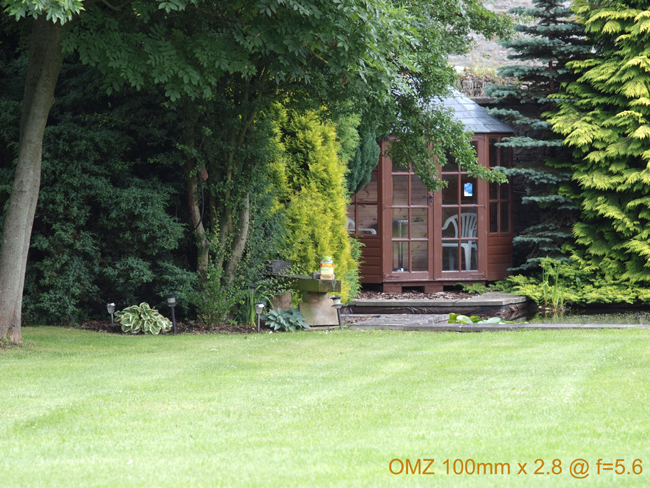
100mm x 2.8: Easy focus with MF assist 10X. No areas to check for purple fringing. I've had good results from this lens on all my E-System cameras. In this test target area sharpness is quite good but not really sharp; the result at f=2.8 is almost as sharp with just a hint of ghosting but certainly usable; the version at f=11 is equal to the 5.6 result with no evidence of diffraction. The EFL is 200mm making this lens a small and capable medium telephoto. It is usable wide open with care with little discernable difference as the aperture is stopped down; quite sharp to f=11.
Click image for full size version.
|
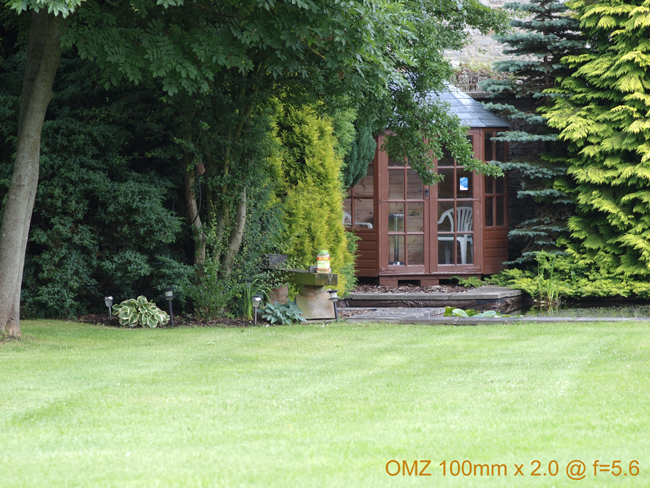
100mm x 2.0: Easy focus with MF assist 10X. No areas to check for purple fringing. This lens is a good performer but is heavy and prone to a bit of CA in high contrast areas. In this test target area sharpness is good, better than its slower sibling as this lens has ED elements; the result at f=2.0 is almost as sharp with no hint of ghosting and very usable; the version at f=11 perhaps slightly less sharp (marginal) with no evidence of diffraction. The EFL is 200mm making this lens a fast and capable medium telephoto albeit heavy. It is usable wide open with little discernable difference as the aperture is stopped down; sharp to f=11.
Click image for full size version.
|
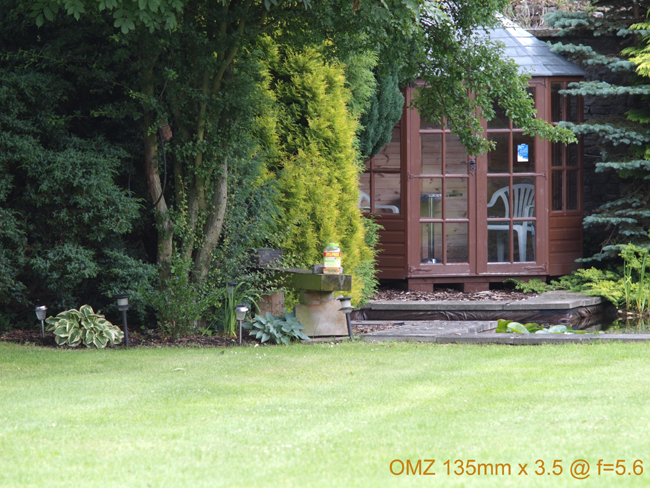
135mm x 3.5: Easy focus with MF assist 10X. No areas to check for purple fringing. This lens has always delivered good results on all my cameras. In this test target area sharpness is good; the result at f=3.5 is just as sharp with no ghosting and very usable; the version at f=11 is starting to lose sharpness presumably due to diffraction. The EFL is 270mm making this lens a capable albeit quite slow medium telephoto. It is usable wide open with little discernable difference as the aperture is stopped down; sharp to f=8.
Click image for full size version.
|
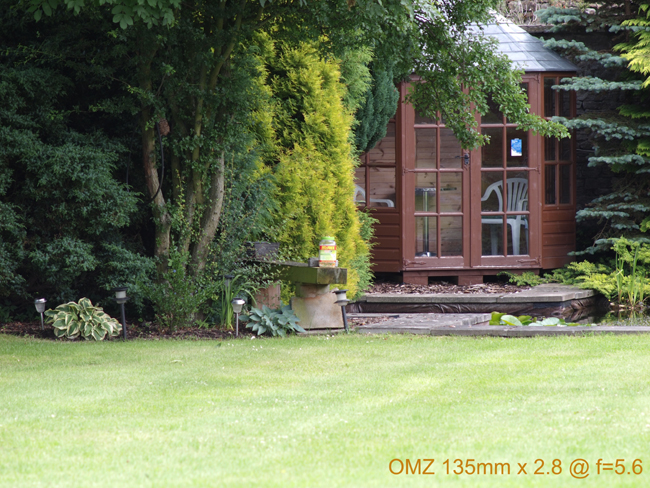
135mm x 2.8: Easy focus with MF assist 10X. No areas to check for purple fringing. Along with the slower version this lens has always delivered good results on all my cameras. In this test target area sharpness is good to very goog, a tad improved on the slower sibling; the result at f=2.8 is just as sharp with no ghosting and very usable; the version at f=11 is just a tad down on sharpness maybe due to diffraction. The EFL is 270mm making this lens a capable and quite fast medium telephoto. It is usable wide open with little discernable difference as the aperture is stopped down; sharp to f=11 (just).
Click image for full size version.
|
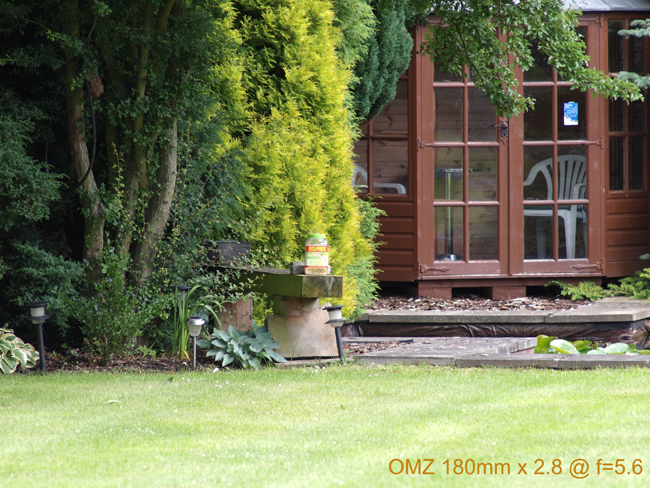
180mm x 2.8: Easy focus with MF assist 10X. There's a small area of purple fringing around the small sign in the window. This lens is prone to CA. The lens is also big and heavy. In this test target area sharpness is very good; the result at f=2.8 is softer with no ghosting and a great bokeh; the version at f=11 is about equal on sharpness. The EFL is 360mm making this lens a capable and quite fast telephoto. It is usable wide open (beware CA) with little discernable difference as the aperture is stopped down; sharp to f=11.
Click image for full size version.
|
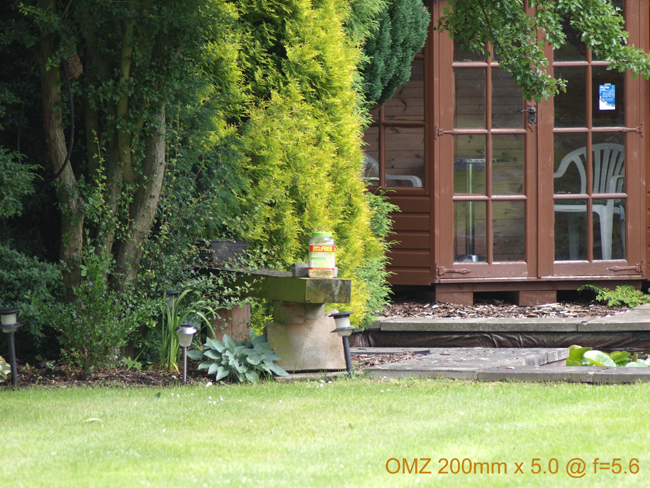
200mm x 5.0: Easy focus with MF assist 10X. Surprisingly, there's a touch of purple fringing around the small sign in the window. I've had consistent results from this lens in the past and do not see CA as a big problem. The lens is small and light but slow. In this test target area sharpness is very good to excellent; the result at f=5.0 is slightly down on sharpness and has little bokeh; the version at f=11 the same. The EFL is 400mm making this lens a small, capable but slow telephoto. It is usable wide open with little discernable difference as the aperture is stopped down; sharp to f=11.
Click image for full size version.
|
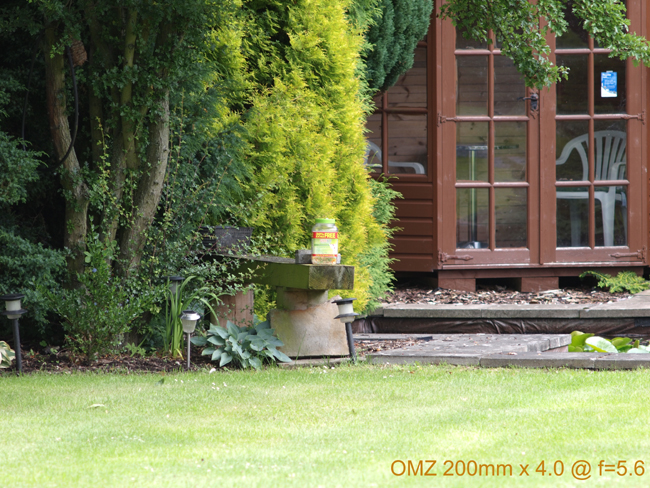
200mm x 4.0: Easy focus with MF assist 10X. No trace of purple fringing in this image. I've had consistent results from this lens in the past. For its f4.0 aperture, the lens is small, light and quite fast. In this test target area sharpness is very good to excellent; the result at f=4.0 is identical as is the version at f=11. The difference is in the amount of bikeh. The EFL is 400mm making this lens a small and capable telephoto. It is usable wide open with little discernable difference as the aperture is stopped down; sharp to f=11~16.
Click image for full size version.
|
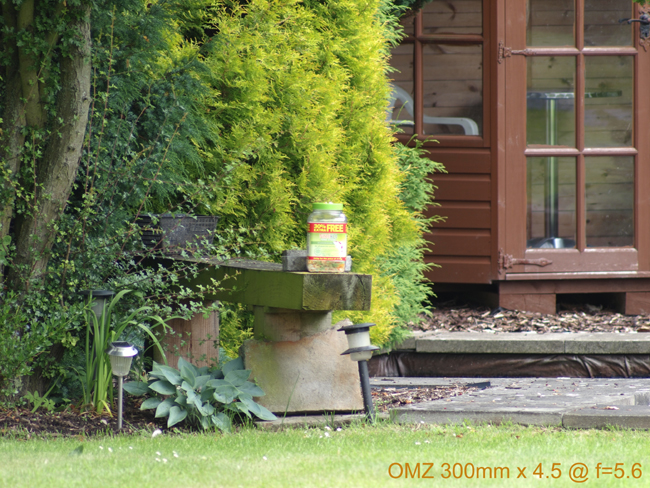
300mm x 4.5: Easy focus with MF assist 10X. A touch of purple fringing in the high contrast areas. The 300mm has delivered good results with all my cameras. The lens is quite large - probably a touch too big for the E-P1 - but fortunately has a tripod ring so you attach the camera to the tripod mounted lens! In the 5.6 test target area sharpness is very good to excellent; the result at f=4.5 is just a tad softer; the result at f=11 is identical. The EFL is 600mm making this lens a powerful and capable super-telephoto. It is usable wide open with care and there's not a great deal of difference as the aperture is stopped down; sharp to f=11~16.
Click image for full size version.
|
SUPER TELEPHOTO LENSES 400MM TO 600MM
Lenses: 400/6.3; 500/8 Mirror; 600/6.5.
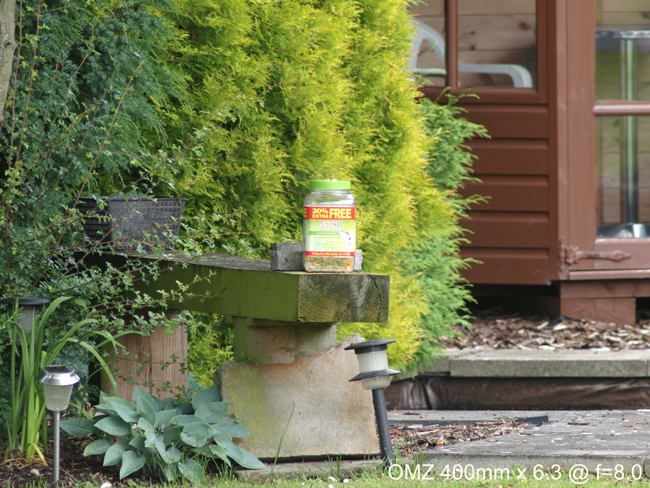
400mm x 6.3: Easy focus with MF assist 10X. No purple fringing that I can see. The 400mm is a bit of a beast and my version is stiff in the focus ring but has delivered good results in previous tests. The lens is large - probably a touch too big for the E-P1 - but fortunately has a tripod ring so you attach the camera to the tripod mounted lens! I shot the images at wide open, F8 and f11. In the f8 test the target area sharpness is very good to excellent; the result at f=6.3 is identical except for bokeh; the result at f=11 is virtually the same. The EFL is 800mm making this lens a very powerful albeit large super-telephoto. It is usable wide open and there's not a great deal of difference as the aperture is stopped down; sharp to f=11~16.
Click image for full size version.
|

500mm x (fixed) 8.0: Reasonably easy focus with MF assist 10X though not as easy as other telephotos. The 500mm Mirror is small and light and quite easy to use but remember the bokeh will produce doughnuts from bright areas and is largely a matter of taste. The lens still requires tripod mounting via the camera. No purple fringing that I can see. The result show the target area sharpness is reasonably sharp. The EFL is 1000mm making this lens a very powerful ans small super-telephoto. It is usable with care, only on a tripod.
Click image for full size version.
|
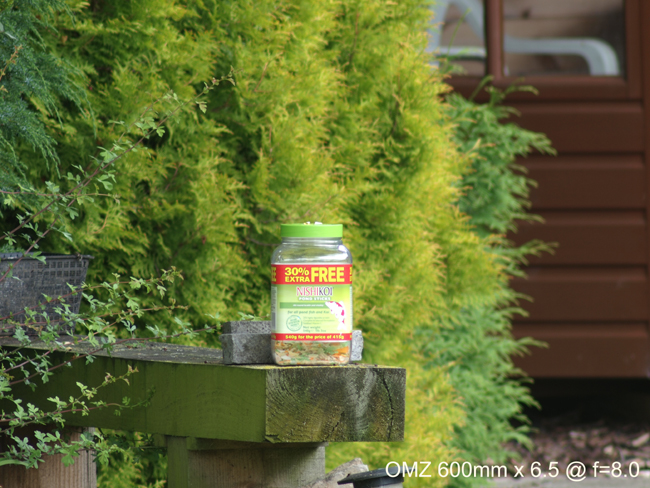
600mm x 6.5: Easy focus with MF assist 10X. This lens is rack and pinion focus. The 600mm is a huge lens and must be tripod mounted. The tiny E-P1 looks slightly ridiculous on the back of this lens! I shot 3 images at wide open, F8 and f11. There is no purple fringing that I can see. In the f8 test the target area sharpness is excellent; the result at f=6.5 is identical except for bokeh; the result at f=11 is also identical. The EFL is 1200mm making this lens a very powerful albeit huge super-telephoto. It is usable wide open and there's no appreciable difference as the aperture is stopped down; sharp to f=16~22. Ideally requires a gimbal tripod to enable swift movement. (This lens was several thousand pounds when new and can be bought for £6-800 today.)
Click image for full size version.
|
OBSERVATIONS & RECOMMENDATIONS
This was a time consuming task that took about half a day to achieve. The harder bit was to put the web page together! I have concentrated on primes at this point as I still believe the OM Zoom lenses are simply too fiddly to use though some results are quite passable. OMZ Macros are superb on the digitised bodies and I hope to devote a separate article to these shortly. I regularly use the 50/3.5; 80/4; 90/2 and to a lesser degree 135/4.
Looking through the test images from the E-P1 it is clear that this new generation of cameras can utilise legacy glass a little better than the latest generation of standard 4/3rds bodies, which in themselves are way better than the first series of 4/3rds like E-1/E-300/E-500. And, I suspect things may improve with later iterations of MFT bodies.
I have recently tested the DANDELION AF confirm adapter here, and found the focus confirm extremely useful when using manual lenses on the E-3/E-620. The Dandelion chip works because it 'pretends' to be a Zuiko Digital lens that focus using the phase detect AF system in the mirror box and plugs into that focus information loop. The E-P1 uses the sensor based contrast detect AF system and it may be very difficult to provide the user with any focus confirmation. BUT, I'm optimistic that Olympus will develop the technology to provide focus confirmation using legacy glass to generally aid good focus, particularly when the screen is washed out by ambient light. If they do this MFT will offer unprecedented advantages for manual glass.
UPDATE ON DANDELION AF CONFIRM ADAPTER
I have now received a micro 4/3rds to 4/3rds adapter and have tested a selection of OMZ's on the E-P1 with this adapter in combination with the Dandelion mentioned above. As well as looking like a Heath Robinson solution I'm afraid my suspicions were correct - it doesn't work. Occasionally the E-P1 will show a green doughnut on the screen but this is totally unreliable and whatever it might be indicating it's not accurate focus.
We will have to wait until Olympus develop a solution as the current after-market options do not work with 'pure' CDAF machines. You are better off relying on your eyesight. (Thanks to Trent Pulliam for passing on his similar experience and reminding me to add this update.)
GENERAL NOTES (no particular order)
There is light fall-off in the corners with the 8mm Fisheye (imaging circle 23mm). I did not notice it with any of the other wide angles (that said I have not considered it a major issue with OMZ wide angles on ordinary 4/3rds.) The lesser registration distance of the E-P1 must provide a better light path to the corners of the sensor.
When using fast wide angle lenses you need to use them closed by one stop to avoid ghosting. The slower ones can be used wide open. They all benefit a little (sharpness wise), by closing to f4~11. To my eyes the sweet-spot for virtually all OMZ's is f=5.6.
The 'standard' range offers some very sharp lenses but the faster ones don't provide much benefit as they ghost wide open. Also, I'm not personally convinced that their focal length is especially usable - but each to his own. However, when reversed the 50/1.8 makes a good and inexpensive Macro lens and reverse ring adapters are cheap. That said the excellent OMZ 50/3.5 Macro can be bought for about £45.
Once telephoto lengths are reached the 2X crop factor really comes into its own. All the OMZ telephoto's will give you good results and some at bargain prices, though I suspect not for too much longer. I have noticed the prices of these lenses in the auctions have been steadily rising over the last two years. I was quite shocked to hear of an OMZ 85/2 being sold for £350 recently.
Most telephotos can be used wide open and give quite sharp results. Not having to stop down is a bonus.
All of the above images will benefit from some post processing. I applied some simple tonal adjustments and a two passes of unsharp mask and was rewarded with some excellent results. Please download a couple for your own post processing. If you want the RAW file let me know here.
RECOMMENDATIONS WITH E-P1
Practice! Remember that when using telephoto's your shutter speed should be 1/equivalent focal length to reduce camera shake. Even with IS enabled this is a good maxim. For example if using an OMZ 200mm shutter speed should be at least 1/400th sec.
Use ESP or CW metering in A or M mode (I prefer ESP/A mode). Metering is accurate. Spot confounds the metering system with OMZ's.
Apply compensation as required by the conditions, not as a matter of course as with E-1.
I found auto WB satisfactory.
Shoot RAW + jpeg - this gives you the opportunity to adjust the exposure later if needed.
SUPPLEMENTARY GLASS?
For anyone with a collection of OMZ glass, the E-P1 (and later 4/3rds cameras) can breathe new life into them. OMZ glass can nicely supplement the rather limited MZ lens choice for now anyway. OMZ primes provide that 'retro' feeling of actually having an input into your photographs - surely this is the whole ethos of the new 'PEN'.
For those without OMZ's who fancy a few supplemental lenses I recommend some or all of these:
21mm x f3.5 or 24mm x f2.8 as a 'standard' lens.
50mm x f=1.8 standard lens for portraiture or macro when reversed.
135mm x f3.5 or 2.8
200mm x f4 or f5
300mm x 4.5
This provides a manual lens range of (equivalent) 42mm to 600mm. If you buy sensibly and over several months you should manage this lot for about £350 based on current prices. I recommend only Olympus OM Zuiko's.
This is an excellent way to re-cycle, saving resources and money. Get them - before they simply disappear.
PEN F to m4/3rds ADAPTER
17th July 2009: I have just received my MFT to Pen F adapter from JinFinance in Hong Kong (RJ Camera adapter Pen F to m4/3rds) so I'll mention it here. It's nicely made but I'm not sure it is worth £60! However, not only does it allow use of my collection of Pen F lenses, it also enables the use of my 7 Pen F to other major system lens adapters I took so long to collect over the years. In the period Pen F was being made, Olympus manufactured adapters to allow Pentax (M42), Nikon, Minolta, Canon, Leica and Exakta to be mounted on Pen F. After the introduction of the OM system, Olympus also made a Pen F to OM adapter.
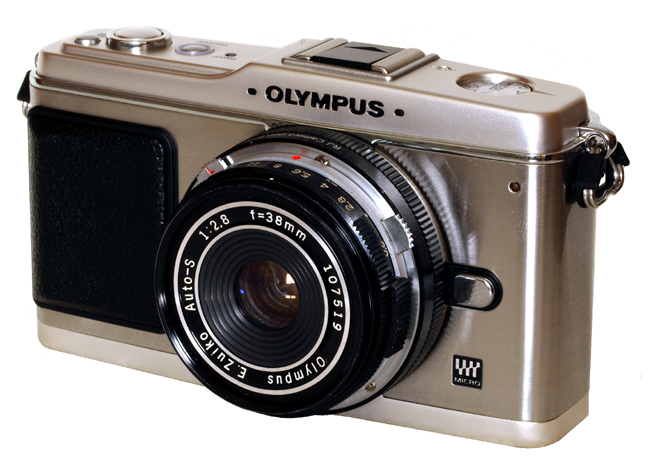
The 'original' Olympus Pancake - Pen F System E Zuiko 38mm x 2.8. Eye candy!
|
I've compared the current Olympus MF-2 against the RJ adapter Pen F to m4/3rds + Pen F to OM, to find they are almost identical in the mount to mount distance. So, if like me you have any of these older Pen F adapters you will be able to use many system lenses on the E-P1 via the RJ camera adapter.
I will be undertaking some tests with my Pen F lenses on the E-P1 but I have to say my quickly gained impression of the Pen 60mm/1.5 and 42/1.2 is promising. More to come in a separate article soon.
If you have any observations please contact me here.
|
Posted July 2009
|
Copyright © 2009 John Foster
|
| 
